We include products in articles we think are useful for our readers. If you buy products or services through links on our website, we may earn a small commission.
Top 8 Intermittent Fasting Tips to Help You Thrive

Intermittent fasting is one of the most popular current health trends. With every tweet about intermittent fasting from celebrities who swear by it including Jennifer Aniston, Hugh Jackman, Gisele Bundchen, and Kourtney Kardashian, thousands of more people are motivated to give IF a try. So whether you’re new to IF, or looking to tweak your existing approach, these intermittent fasting tips and tricks can set you on the right path, without relying on a fancy personal nutritionist.
Table of Contents
What is Intermittent Fasting?
Put simply, intermittent fasting means cycling between periods of eating and not eating.
The reasoning behind it is that this way of eating mimics ancestral eating patterns. When we eat in alignment with the way our bodies evolved for millions of years, we can optimize our health and wellbeing.
The benefits of intermittent fasting may include [1][2][3][4]:
- Lowers and regulates blood sugar
- Reduced cholesterol and triglycerides
- human growth hormone stimulation
- Stem cell activation and cellular repair
- Reduced inflammation
- Increased longevity
- mindful eating
- fat burning and weight loss
1. Experiment with Different Intermittent Fasting Schedules
There are various intermittent fasting schedules to choose from, depending on your individual metabolic needs along with your activity levels.
Some people jump right into more restrictive approaches like the OMAD diet (One Meal a Day) and thrive on it. While others take a graduated approach.
The key tip here is to bring in some curiosity and give yourself some time to figure out the method that’s right for you. The simple act of paying attention to your dietary habits and the way your body responds is itself a big step towards reclaiming your metabolic health.
If you’re the type of person that likes to test the water before diving into the deep end, try a circadian rhythm fast that synchronizes your eating with your internal body clock.
Here’s a rundown of some of the most popular intermittent fasting methods listed from least to most intense:
Circadian Rhythm Fasting
Circadian rhythm fasting calls for eating only during the daylight hours when our bodily functions like digestion and metabolism are most active. It often entails eating two large satiating meals each day, one mid-morning, and the second just before sundown.
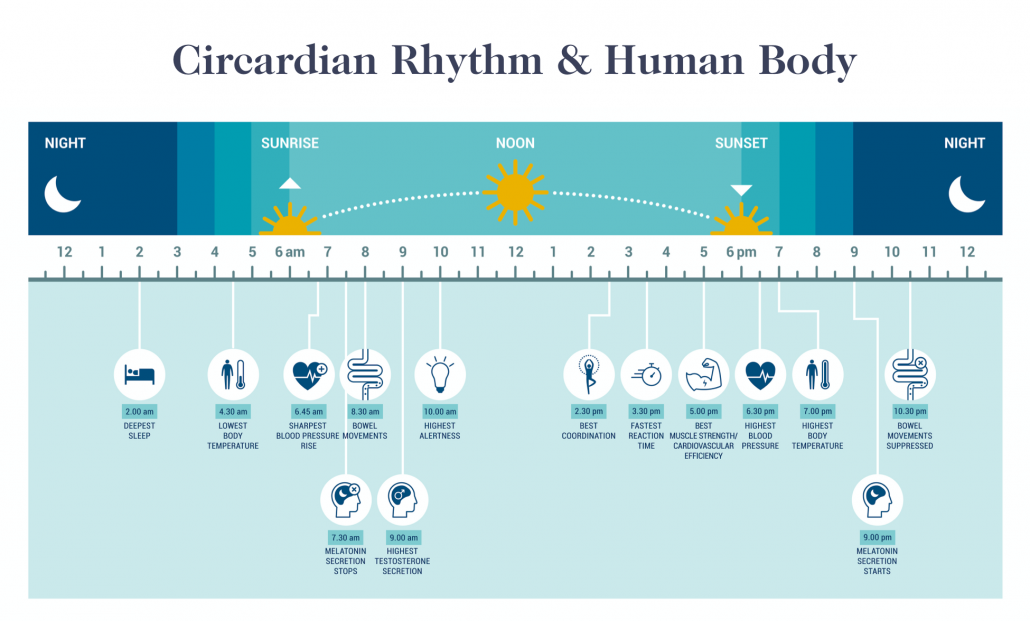
Brunch Fast (AKA 12-14 Hour Fast)
This gentle fast may be more suitable for women since women are more susceptible to hormone imbalances as a result of caloric restriction. The brunch fast entails 12-14 hours of fasting. The first meal is usually a late breakfast or brunch.
If you’re a woman interested in intermittent fasting we recommend reading more here.
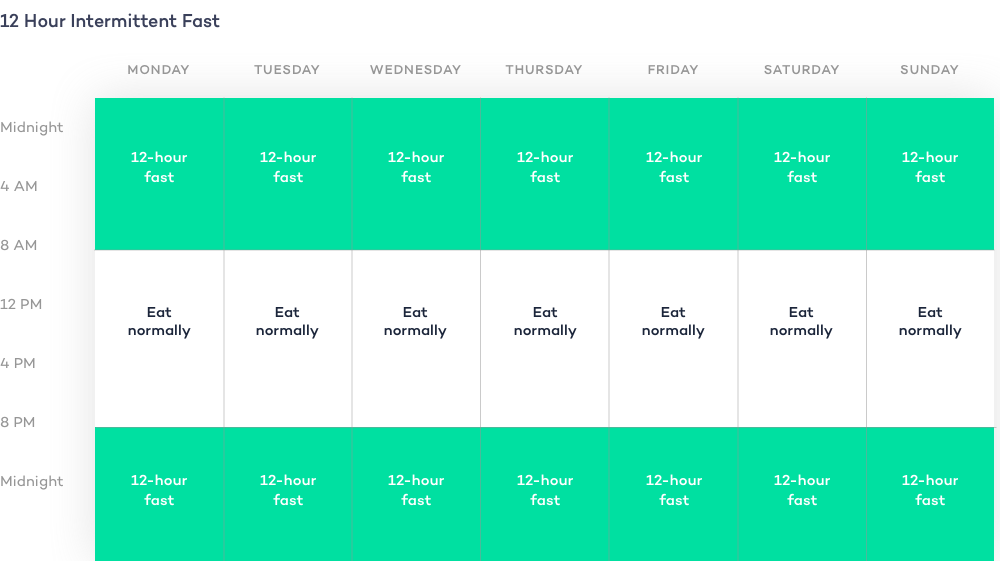
16/8 Fasting
16/8 fasting usually entails skipping breakfast and eating within an 8 hour period. 11-7 p.m. is a common eating window, outside of which you fast for 16 hours.
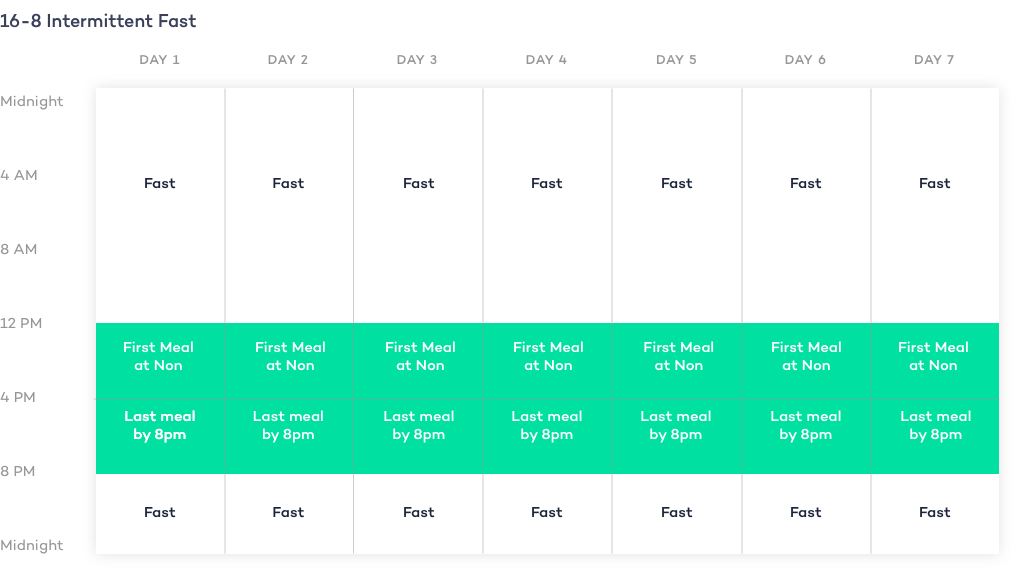
Eat Stop Eat
The Eat Stop Eat approach to intermittent fasting entails not eating for 24 hours once or twice a week. But as you can see this doesn’t mean skipping an entire day of the week–so it’s less intense than alternate day fasting.
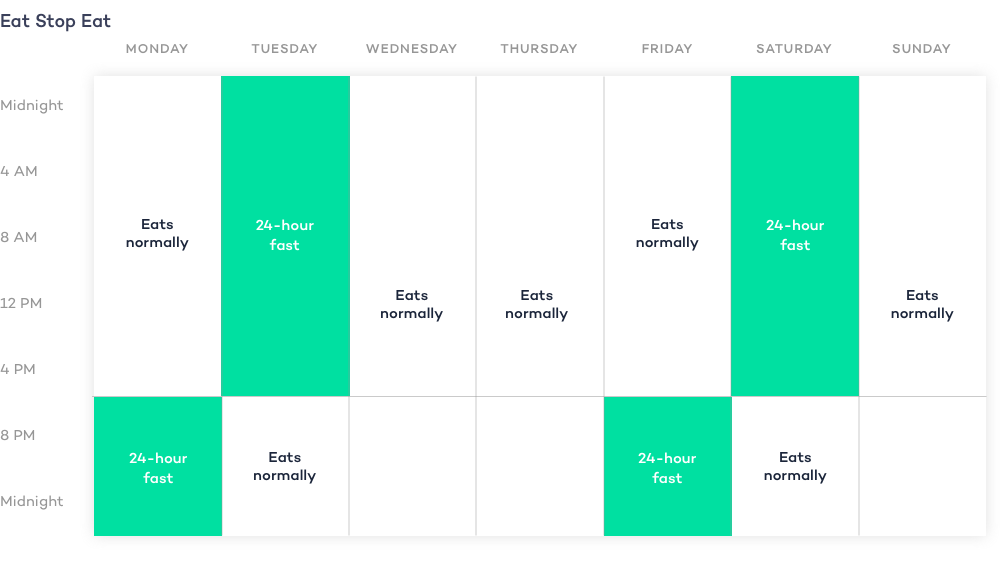
OMAD Fasting
OMAD is the acronym for One Meal A Day. Most people who go OMAD take their meal shortly after sunset, or more generally in the evening. Though others prefer one large meal around noon.
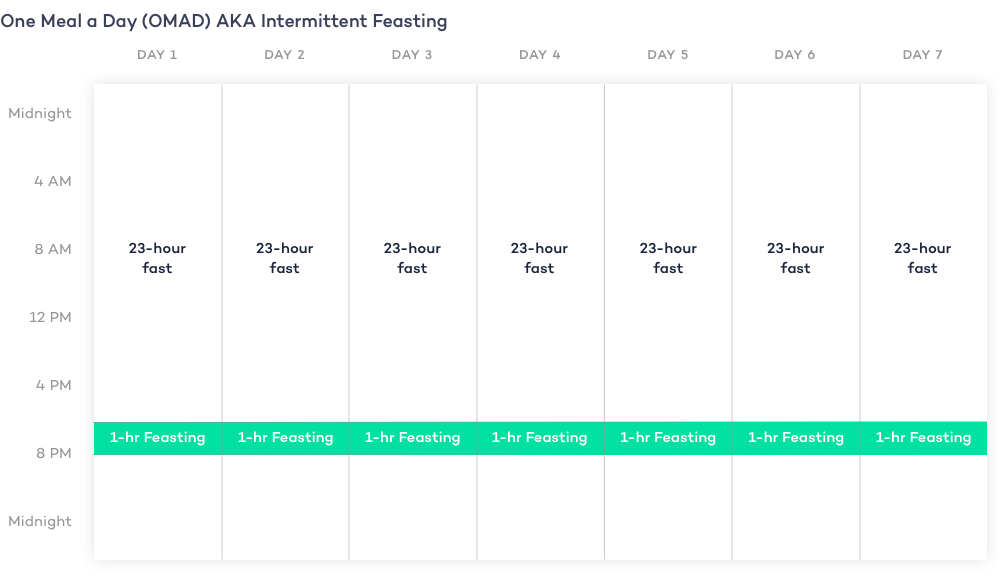
2. Make Sure You’re Eating Enough
Intermittent fasting is not necessarily about restricting calories. In fact, the weight loss benefits come from a combination of reduced snacking, better food choices, and improved metabolic function. In fasted states, the body can begin to metablize fat into energy molecules known as ketones.
Most adults need around 2000 high quality calories per day to thrive. If you’re eating the standard American diet, you’re likely used to spreading these calories out over three meals of low-nutrient foods with snacks in between.
For many people, it can feel like a challenge to fit your caloric needs into a smaller eating window, especially when eating only one or two meals a day.
Keep in mind that consuming too few calories can damage your immune system, slow your thyroid, and make losing weight more difficult [4][5]. These issues are exaggerated for athletes and people who already have trouble keeping weight on.
This is where choosing what to eat during intermittent fasting can be as important as when to eat.
3. Eat Nutrient-Dense and Satiating Foods
Choosing the most nutrient-dense and satiating foods is probably the most important intermittent fasting tip to keep in mind.
The right foods will help you meet your caloric needs within a shorter eating window and with fewer meals. While at the same time these satiating foods will stave off hunger cravings during fasting periods.
The chart below reveals the array of essential nutrients packed into eggs, the best cuts of steak, and liver.
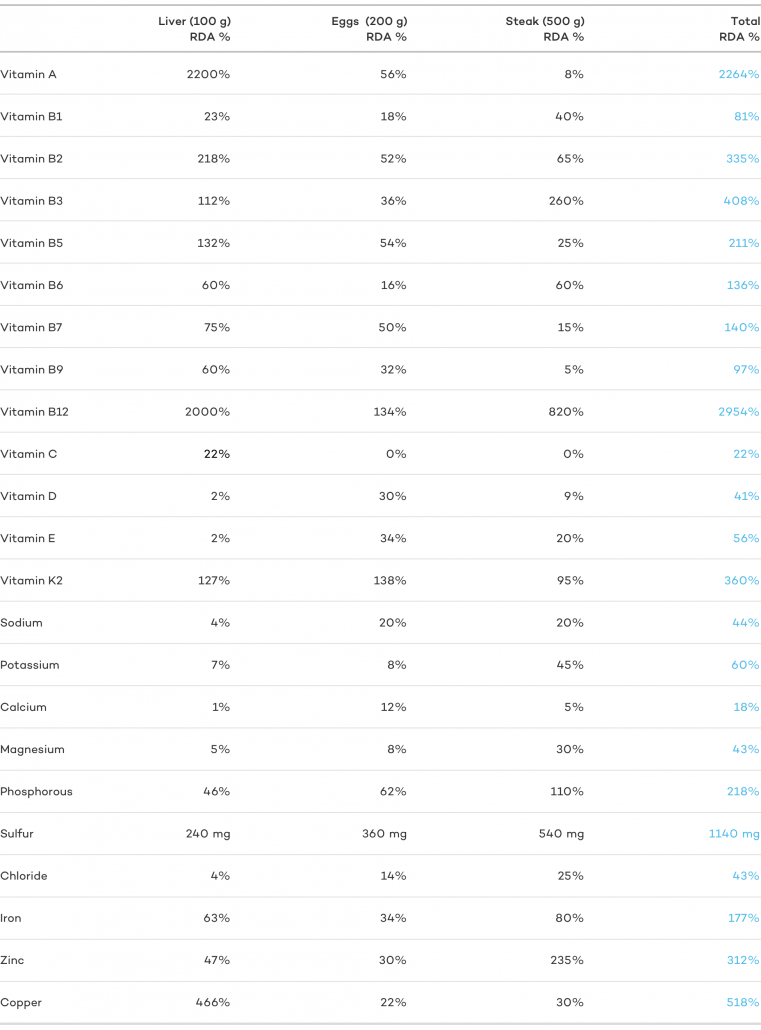
Fatty Meats from Grass-Fed and Pasture-Raised Sources
Start by centering your meals around fatty meats from grass-fed and pasture-raised sources. Meat provides nutrients that you can’t get from other food sources.
You can learn more about the benefits of eating meat here.
Here’s a rundown of the most nutrient dense and satiating foods to eat while intermittent fasting:
- Ruminant meat from cows, bison, lamb, and wild game (grass-fed and pasture-raised when possible)
- organ meats (try organ meat supplements if fresh organ are unpalatable or hard to find)
- Eggs
- Butter
- Tallow
- Low-carb yogurt
- Bone broth
- Oysters, Salmon roe fatty fish, and other seafood
- Low-carb fruit like berries
- Properly-prepared low-carb vegetables
Add Healthy Fats
Adding 1-4 tablespoons of healthy fats is an easy and nutritious way to boost your caloric intake. Adding more fat to the last meal of the day can help fuel your body through the night, aiding in better sleep.
Fats have nearly twice as many calories per gram than carbs and protein, so it doesn’t take much to make a large caloric impact.
The medium-chain fatty acids found in coconut oil can support the process of ketosis where the body breaks down fat for energy when in a fasted state [6].
10 of the healthiest fats you can add to your intermittent fasting regimen are:
4. Plan Meals Ahead of Time
After not eating for extended periods of time it can be tempting to break a fast with snacks and junk food.
This makes sense when considering that studies show that the most addictive foods are loaded with a combination of processed fats and sugars [7].
By planning your meals ahead of time you seed your mind with a clear choice, reducing your need to make choices when your blood sugar is already low. Studies show that “decision fatigue” is influenced by low blood sugar, making it more likely to revert to familiar and even addictive choices. In the case of diet, this can mean falling into the trap of carb addiction [8].
5. Prep your Meals in Advance
The intermittent fasting tip of prepping your meals in advance can be the golden ticket to sustained IF success.
Meal prep saves you time, reduced decision fatigue that can send you spiraling into junk food binges, and ensures that you’ll be getting the nutrients you need to thrive.
6. Stay Hydrated
People often confuse not eating with not drinking. Intermittent fasting is about restricting calories for part of each day, but requires that you drink plenty of non-caloric beverages.
Mineral water, herbal teas, and black coffee are all acceptable answers to the question of what to drink during intermittent fasting.
Studies show that coffee may even enhance your metabolic rate, thereby increasing the fat burning benefits of intermittent fasting [9][10].
When practicing more intense fasts, and when combining fasting and more intensive physical activity, your body can enter into deeper states of ketosis. In these instances, your body will dump fluids as it accesses the glycogen stored in your muscles. This process makes it even more important to rehydrate often with the help of added salt.
7. Combine Intermittent Fasting With Keto
A natural extension of the food suggestions above is to combine intermittent fasting and keto.
A high-fat low-carb diet can reduce hypoglycemic stress and protect against hormone imbalances that can occur over prolonged calorie restriction while promoting greater blood sugar stability.
A 2-meal a day keto and intermittent fasting meal plan can look like this:
8. Combine Intermittent Fasting With Other Healthy Lifestyle Choices
Another powerful intermittent fasting tip has little to do with when and what to eat. Rather, it calls for combining healthy diet and lifestyle can supercharge their combined benefits. Nurturing movement practices like yoga, walking, swimming, meditation, gratitude practrices, visualizations, and daily intentions are all mutually supportive.
True and lasting health and wellness considers nutrition, physical needs, and mental balance.
Intermittent Fasting Tips: The Bottomline
Intermittent fasting is a safe and popular way of restricting your meals times to induce numerous health benefits.
Yet, the most important intermittent fasting tip to remember is that what you eat is as important as when you eat it.
Choosing nourishing and nutrient-dense foods can more completely unlock the benefits of intermittent fasting. An intermittent fasting diet based on whole animal foods aligns your evolutionary physiology with the eating habits that humans evolved to thrive on.
Supporting your intermittent fasting practice with intentional movement, meditation, and positive habits can create a powerful synergy of mind-body health and wellbeing.




















